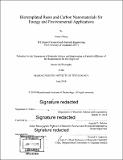| dc.contributor.advisor | Angela M. Belcher. | en_US |
| dc.contributor.author | Zhang, Geran. | en_US |
| dc.contributor.other | Massachusetts Institute of Technology. Department of Materials Science and Engineering. | en_US |
| dc.date.accessioned | 2019-07-18T20:34:40Z | |
| dc.date.available | 2019-07-18T20:34:40Z | |
| dc.date.copyright | 2018 | en_US |
| dc.date.issued | 2018 | en_US |
| dc.identifier.uri | https://hdl.handle.net/1721.1/121831 | |
| dc.description | Thesis: Ph. D., Massachusetts Institute of Technology, Department of Materials Science and Engineering, 2018 | en_US |
| dc.description | Cataloged from PDF version of thesis. | en_US |
| dc.description | Includes bibliographical references (pages 171-185). | en_US |
| dc.description.abstract | The M13 bacteriophage had been shown to be a highly versatile toolkit for growing and assembling nanomaterials with technological importance. Inspired by the natural biomineralization process, much of the existing literature focused on genetically engineering the M13 viral capsid for interaction with inorganic materials, such as metals and oxides. In this thesis, the utility of the M13 toolkit was extended to the synthesis of organic and carbonaceous materials. Biotemplating of phenolic resins was extensively studied, with a particular focus on colloidal assembly and materials chemistry. Genetically engineered M13 bacteriophage was shown to be particularly apt at controlling the morphology and selfassembly of phenolic resin nanofibers. The properties of these nanomaterials could be simultaneously controlled by introducing additional molecular moieties using simple aqueous, organic chemistry, to enable their application as catalyst scaffolds and carbon dioxide sorbents. | en_US |
| dc.description.abstract | Modification of the phenolic resin nanofibers with organosilicon moieties offered a direct route to nanoporous carbon nanofibers upon carbonization. The properties of these biotemplated carbon nanofibers could be tailored for specific applications by independently controlling morphology and carbon texture. Their practical utility was demonstrated by the rapid adsorption of small molecules with uptake values comparable to some highest values reported for carbon materials. High conductivity nanofibers could also be incorporated into lithium-sulfur batteries as interlayers to significantly improve electrochemical performance. New biotemplating approaches to the synthesis of some other inorganic nanomaterials such as zinc sulfide and noble metal nanomaterials were also demonstrated. Biotemplated zinc sulfide nanofibers were shown to be promising anode material for sodium-ion batteries, with potential for further study. | en_US |
| dc.description.abstract | The facile synthesis of a range of noble metal nanowires opens up potential applications in catalysis and energy storage. | en_US |
| dc.description.statementofresponsibility | by Geran Zhang. | en_US |
| dc.format.extent | 185 pages | en_US |
| dc.language.iso | eng | en_US |
| dc.publisher | Massachusetts Institute of Technology | en_US |
| dc.rights | MIT theses are protected by copyright. They may be viewed, downloaded, or printed from this source but further reproduction or distribution in any format is prohibited without written permission. | en_US |
| dc.rights.uri | http://dspace.mit.edu/handle/1721.1/7582 | en_US |
| dc.subject | Materials Science and Engineering. | en_US |
| dc.title | Biotemplated resin and carbon nanomaterials for energy and environmental applications | en_US |
| dc.type | Thesis | en_US |
| dc.description.degree | Ph. D. | en_US |
| dc.contributor.department | Massachusetts Institute of Technology. Department of Materials Science and Engineering | en_US |
| dc.identifier.oclc | 1108620067 | en_US |
| dc.description.collection | Ph.D. Massachusetts Institute of Technology, Department of Materials Science and Engineering | en_US |
| dspace.imported | 2019-07-18T20:34:35Z | en_US |
| mit.thesis.degree | Doctoral | en_US |
| mit.thesis.department | MatSci | en_US |
